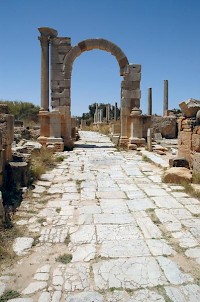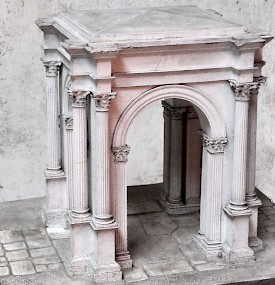Lepcis Magna, Arch of Trajan
Q21647664Lepcis Magna: Phoenician colony, later part of the Carthaginian empire, the kingdom of Massinissa, and the Roman empire. Its most famous son was the emperor Septimius Severus (r.193-211).

The citizens of Lepcis Magna had reasons to be grateful to the Roman emperor Trajan (r.98-117). Sometime after his successful campaigns in Dacia, which had been conquered in 106, he awarded the Tripolitan city the rank of colonia, and it was from now on officially called Colonia Ulpia Traiana Lepcitaniorum. This meant that the city was regarded as a "little Rome": all free-born, male inhabitants had full citizenship, the city was to be ruled by two magistrates (comparable to the consuls), and there had to be a temple called Capitol, where the supreme gods of the Romans, Jupiter, Juno, and Minerva, had to be venerated.
To express their gratitude, the Lepcitanians dedicated an elegant honorific arch to their benefactor, not far from the Chalcidicum (of which you can see two columns to the right).
The Arch of Trajan now looks modest because only one limestone arch is standing, but it used to have four, and it might be called a quadrifrons or a tetrapylon. On the four corners, one could see two lovely Corinthian columns, and their were similar columns inside the arch, supporting the roof, which may have been a low cupola. The inscription, known as IRT 353, reads:
IMPeratori CAESARI DIVI NERVAE F. NERVAE TRAIANO AVGVSTO GERManico
DACICO PONTifici MAXimo TRIBvnicia POTestate XIIII IMPeratori VI COnSvli V Patri Patriae CON...
ORDO ET POPVLVS COLONIAE VLPIAE TRAIANAE FIDELIS LEPCIS MAGNAE ARCVM
CVM ORNAMENTIS PECVNIA PVBLICA FECERVNT (more...)

Which can be translated as
To the emperor, caesar, son of the divine Nerva, Nerva Trajan Augustus Germanicus, Dacicus, pontifex maximus, in the fourteenth year of his tribunicial powers, six times imperator, five times consul, father of the fatherland, [...] have the Council and Assembly of the Loyal Colonia Ulpia Traiana Lepcis Magna dedicated this arch with ornaments, from public funds.

The inscription, which can be dated to the years 106-111, is the first reference to Lepcis' status as colonia. It covered the crossroads of the Cardo and the road to the Theater. The four-faced design is similar to the Arch of Septimius Severus, which was built almost a century later, is within sight from the Arch of Trajan, and may have been inspired by the older monument.
The elephant that is now in the central hall of the Museum of Lepcis Magna, was discovered near the Arch of Trajan.
The final photo shows to the right, in the background, the Theater.